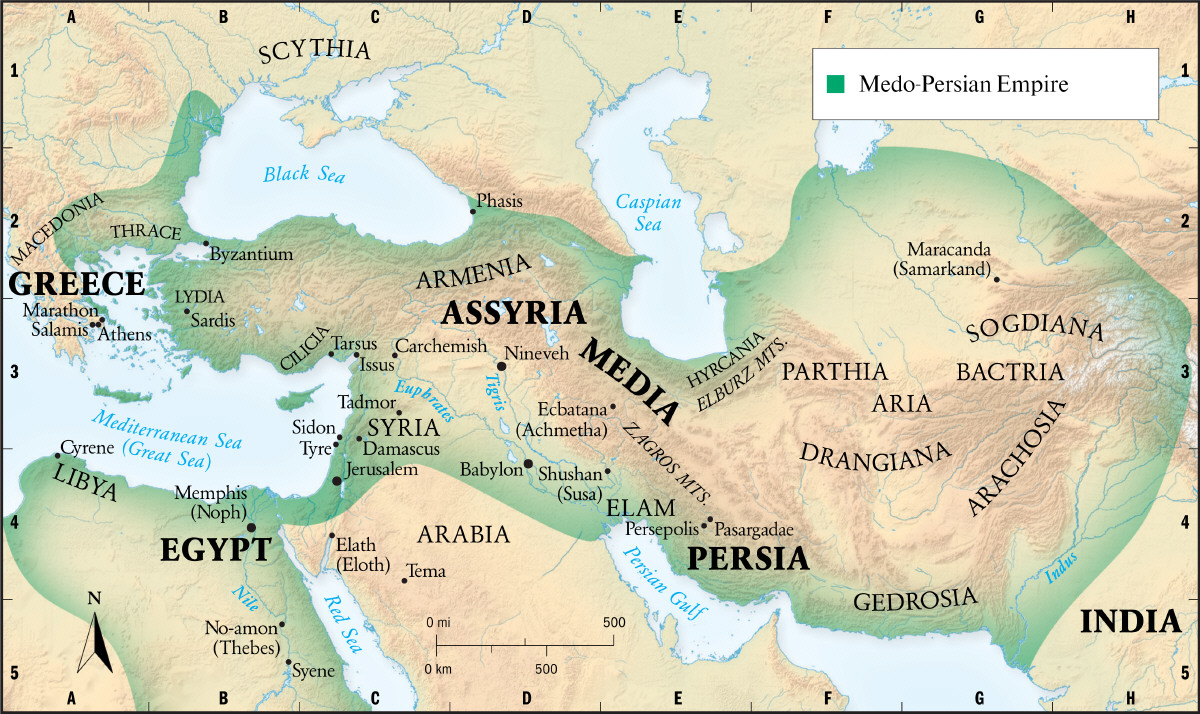The content displayed below is for educational and archival purposes only.
Unless stated otherwise, content is © Watch Tower Bible and Tract Society of Pennsylvania
You may be able to find the original on wol.jw.org
God’s People Return to Their Land

TWO notable mountain ranges rim the plateau of modern Iran—the Elburz (south of the Caspian Sea) and the Zagros (southeast toward the Persian Gulf). They are broken by long, fertile valleys with tree-covered slopes. The valleys enjoy a temperate climate, but the higher, arid, windswept plains are frigid in winter. Nearby is the sparsely populated desert of the plateau. In this general region, east of Mesopotamia, the Medo-Persian Empire arose.
The Medes were centered on the northern part of the plateau, although they later spread into Armenia and Cilicia. The Persians, though, were centered on the southwestern part of the plateau, east of the Tigris Valley. Under Cyrus’ rule in the middle of the sixth century B.C.E., these two kingdoms united, forming the Medo-Persian World Power.
Cyrus captured Babylon in 539 B.C.E. His empire extended eastward to India. Westward, it came to include Egypt and what is now Turkey. Daniel fittingly described the Medo-Persian Empire as a rapacious “bear” that ‘ate much flesh.’ (Da 7:5) Cyrus established a humane, tolerant rule. He divided the empire into provinces. Each was ruled by a satrap, usually a Persian, but under him, a local ruler exercised some authority. The peoples of the empire were encouraged to retain their customs and religions.
In keeping with this policy, Cyrus allowed the Jews to return to restore true worship and to rebuild Jerusalem, as described by Ezra and Nehemiah. Do you think that this large body returned by the route Abraham had taken up the Euphrates toward Carchemish, or did they perhaps take the shorter route through Tadmor and Damascus? The Bible does not say. (See pages 6-7.) In time, Jews also settled in other parts of the empire, such as the Nile Delta and places farther south. A sizable Jewish population persisted in Babylon, likely explaining the apostle Peter’s visit there centuries later. (1Pe 5:13) Yes, the Medo-Persian Empire had a role in Jews’ being found in many locations during the succeeding Grecian and Roman empires.
After conquering Babylon, the Medo-Persians used the city, with its torrid summers, as an administrative center. Shushan, the former Elamite capital, was one of the royal cities. Later, that is where Persian King Ahasuerus (evidently Xerxes I) made Esther his queen and thwarted a plot to exterminate God’s people across the vast empire. Two other Medo-Persian capitals were Ecbatana (situated at an elevation of over 6,200 feet [1,900 m], with delightful summers) and Pasargadae (at the same altitude, about 400 miles [650 km] to the southeast).
How did this world power end? At the height of its power, Medo-Persia responded to uprisings fomented by Greeks at the northwestern border. Greece was then divided into warring city-states, but these cooperated to defeat Persian forces in decisive battles at Marathon and Salamis. This set the stage for the supremacy of a unified Greece over Medo-Persia.
[Box on page 25]
Under the leadership of Zerubbabel, almost 50,000 Israelite men made the journey of 500 to 1,000 miles (depending on the route) back to Jerusalem. What they faced was a grave economic situation. Their land had lain desolate for seven decades. The repatriates started restoring true worship by rebuilding the altar and offering up sacrifices to Jehovah. In the fall of 537 B.C.E., they celebrated the Festival of Booths. (Jer 25:11; 29:10) Then, the returnees laid the foundation of Jehovah’s house.
[Box on page 25]
BIBLE BOOKS FROM THIS PERIOD:
Daniel
Haggai
Zechariah
Esther
Psalms (part)
1 and 2 Chronicles
Ezra
Nehemiah
Malachi
[Map on page 24]
(For fully formatted text, see publication)
Medo-Persian Empire
A2 MACEDONIA
A2 THRACE
A4 Cyrene
A4 LIBYA
B2 Byzantium
B2 LYDIA
B3 Sardis
B4 Memphis (Noph)
B4 EGYPT
B5 No-amon (Thebes)
B5 Syene
C3 CILICIA
C3 Tarsus
C3 Issus
C3 Carchemish
C3 Tadmor
C3 SYRIA
C3 Sidon
C3 Damascus
C3 Tyre
C4 Jerusalem
D2 Phasis
D2 ARMENIA
D3 ASSYRIA
D3 Nineveh
D4 Babylon
E3 MEDIA
E3 Ecbatana (Achmetha)
E3 HYRCANIA
E4 Shushan (Susa)
E4 ELAM
E4 Pasargadae
E4 Persepolis
E4 PERSIA
F3 PARTHIA
F4 DRANGIANA
G2 Maracanda (Samarkand)
G3 SOGDIANA
G3 BACTRIA
G3 ARIA
G4 ARACHOSIA
G4 GEDROSIA
H5 INDIA
[Other locations]
A2 GREECE
A3 Marathon
A3 Athens
A3 Salamis
C1 SCYTHIA
C4 Elath (Eloth)
C4 Tema
D4 ARABIA
[Mountains]
E3 ELBURZ MTS.
E4 ZAGROS MTS.
[Bodies of water]
B3 Mediterranean Sea (Great Sea)
C2 Black Sea
C5 Red Sea
E2 Caspian Sea
E4 Persian Gulf
[Rivers]
B4 Nile
C3 Euphrates
D3 Tigris
H4 Indus
[Picture on page 24]
Cyrus’ troops had to cross the Zagros Mountains to reach Babylon
[Picture on page 25]
Top: The Gate of All Nations, at Persepolis
[Picture on page 25]
Inset: Cyrus’ tomb, at Pasargadae